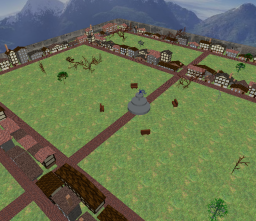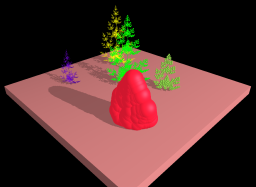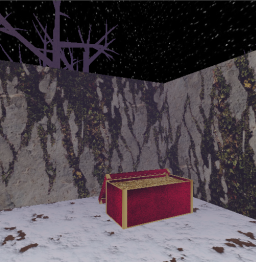Difference between revisions of "Project7Fall11Summaries"
From Immersive Visualization Lab Wiki
(→Winter Woods Maze (Shannon McPeak, Chris McFarland)) |
|||
| Line 1: | Line 1: | ||
| + | {| border="1" cellspacing="0" | ||
| + | | [[Image:2011-p3.png]] | ||
| + | | | ||
| + | ==Procedural Victorian City (Cathy Hughes, Zhanzhan He)== | ||
| + | |||
| + | '''Theme and Story''' | ||
| + | |||
| + | We created a procedurally generated Victorian-inspired city which can be explored through means of a first person character control system. | ||
| + | Specific Rendering Effects | ||
| + | |||
| + | The world has a park filled with trees and bushes generated by L-Systems surrounded by buildings generated using procedural modelling. We seed the world generation using a string supplied by the user, similar to games such as Minecraft. If the user finds a world they particularly like, it can be reproduced by supplying the same seed. | ||
| + | |||
| + | The buildings are randomly sized boxes with various numbers of randomly sized windows and doors, as well as a slanted roof of varying pitch and orientation. The number of stories of the houses are also randomly generated. | ||
| + | |||
| + | We created a 1st person control scheme similar to that seen in video games. The user is able to walk around and explore the world using the w-s keys to move forward and back, a-d to rotate side to side, and q-z to rotate up and down. | ||
| + | |||
| + | '''Creative Efforts''' | ||
| + | |||
| + | We used seamless repeating textures for our buildings (including thatched roofs, stone and timber-framed walls, and brick chimneys) and appropriate colors for our plants to convincingly convey our Victorian theme. | ||
| + | |||
| + | We also made the world as non repetitive as possible. We achieved this by generating different varieties of trees and plants using different L-System rules and randomizing their placement. We also have a library of textures for walls, roofs, doors and windows of buildings from which we select randomly to improve the amount of variation. | ||
| + | |||
| + | The park also features a fountain which shoots L-System generated water and is surrounded by wooden park benches. | ||
| + | |||
| + | To improve the realism of the world, we render it in a bounding box or with a texture to represent the sky and use the built in OpenGL lighting. | ||
| + | |||
| + | '''Feature Summary''' | ||
| + | * Randomly textured buildings | ||
| + | * Randomly sized and shaped buildings | ||
| + | * Bracketed 3D L-Systems | ||
| + | * Stochasitic 3D L-Systems | ||
| + | |} | ||
| + | |||
{| border="1" cellspacing="0" | {| border="1" cellspacing="0" | ||
| [[Image:2011-p11.png]] | | [[Image:2011-p11.png]] | ||


